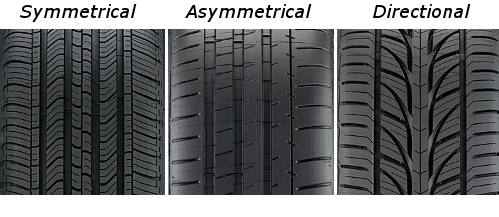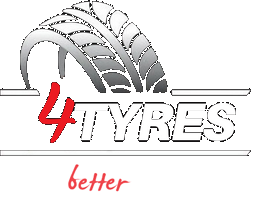Tread Patterns
Directional Tire Tread Patterns
There are three basic types of tread patterns: Symmetrical, Directional, and Asymmetrical. Each tread pattern type incorporates design elements for optimal performance in specific conditions. It is important to know what type of tread style you have on your tires so you can ensure that they have been installed in the correct position, and that they are always correctly rotated during service intervals.

Symmetric Treads: These are the most common type of tread pattern for standard sedans and light trucks. These tires use continuous ribs or blocks across the entire surface of the tire. The pattern on each side of the tire is the exact same. The benefits are even wear and long tread life since there are multiple front-to-back, side-to-side or diagonal rotation options to keep all four tires wearing at the same rate.
Directional Treads: A directional tread pattern is designed to roll only in one direction. For this reason, the tires always have arrows molded on the sidewalls indicating the direction that the tire needs to be mounted. Lateral grooves on both sides of the tire point toward the center of the tire, creating a ‘v’ shape. These grooves very efficiently pump water through the tread so the tire can maintain contact with the road for wet traction and to resist hydroplaning even at high speeds. Another benefit of a directional tread pattern on high performance vehicles is that they give more of an on-center feel for improved high speed stability. The drawback of a directional tread pattern versus a symmetric tread pattern is that they typically wear faster, and are harder to rotate, as they can only be moved from front to back on the same side of the vehicle.
Asymmetric Treads: Tires with asymmetric treads carry markings on the sidewall that indicate the ‘inboard’ and ‘outboard’ so you know which way they need to be mounted. This type of tread pattern is primarily for ultra high performance summer tires on sports cars or high end luxury sedans.
Asymmetric treads have all the benefits of directional treads, but with an added benefit of having a tread pattern optimized for the inboard side of the tire, and a different tread pattern on the outboard side. This means the tread grooves can be aligned to best serve the function of the specific part of the tire. For example, very often an asymmetric tire has a solid outside shoulder for grip in extreme cornering. At high speeds the weight of the vehicle is pushed to the outside edge of the tire so more rubber in contact with the road surface is beneficial. To compensate for the closed outside shoulder, the inside shoulder of the tire will likely have twice as many grooves to allow for water evacuation.High performance vehicles driven at the high speeds can benefit from this type of tread pattern.
